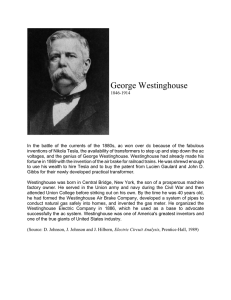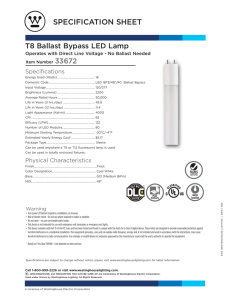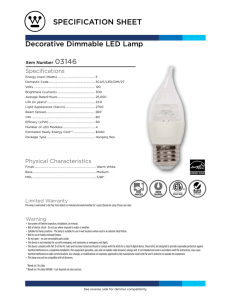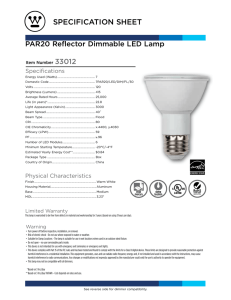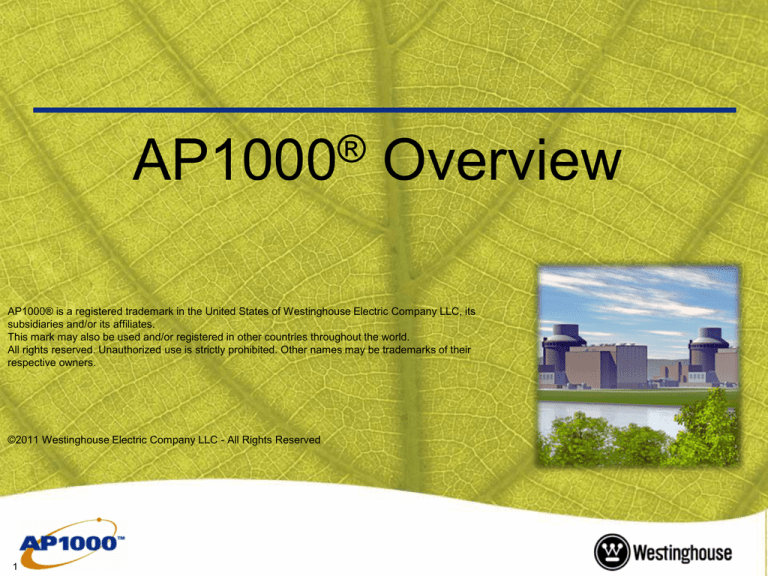
®
AP1000
Overview
AP1000® is a registered trademark in the United States of Westinghouse Electric Company LLC, its
subsidiaries and/or its affiliates.
This mark may also be used and/or registered in other countries throughout the world.
All rights reserved. Unauthorized use is strictly prohibited. Other names may be trademarks of their
respective owners.
©2011 Westinghouse Electric Company LLC - All Rights Reserved
1
Westinghouse Non-Proprietary Class 3
© 2011 Westinghouse Electric Company LLC. All Rights Reserved.
Agenda
● AP1000 Design Philosophy
– AP1000 Passive safety functions
– AP1000 Robustness against external events
● AP1000 Licensing Activities & Status
● AP1000 Deployment Activities & Status
2
Westinghouse Non-Proprietary Class 3
© 2011 Westinghouse Electric Company LLC. All Rights Reserved.
AP1000 Plant Design Objectives
● Greatly Simplified Plant
– Construction, Maintenance, Operation, Safety
● Increased Operation and Safety Margins
– Design Basis Accidents, PRA (core melt prevention & mitigation)
● Competitive Cost of Power, Less Than Coal Plant
● Short Construction Schedule (3 Years for nth of a kind)
● Modular Construction, Leverage simplification to maximize certainty of cost,
schedule, and enhance quality through workshop fabrication
● Licensing Certainty & Reduced Customer Costs
– NRC Final Design Approval / Certification – extensive testing of passive systems
– Pre-Engineered / Pre-Licensed Standard Design: Reduce Costs, Increase
Licensing Certainty
● No Plant Prototype; Proven Components / Systems
● Improved Availability, Inspection, ORE, Maintenance
3
Westinghouse Non-Proprietary Class 3
4
© 2011 Westinghouse Electric Company LLC. All Rights Reserved.
Westinghouse Non-Proprietary Class 3
Westinghouse AP1000
A compact station
• 3415 MWt. Primary system
• 1100 MWe Class
• 2-loops, 2 steam generators
5
© 2011 Westinghouse Electric Company LLC. All Rights Reserved.
Westinghouse Non-Proprietary Class 3
© 2011 Westinghouse Electric Company LLC. All Rights Reserved.
AP1000 Approach to Safety
● Passive Safety-Related Systems
– Use “passive” processes only, no active pumps, diesels, ….
– One time alignment of valves
– No support systems required after actuation
– Greatly reduced dependency on operator actions
– Mitigate design basis accidents without active systems
– Meet NRC PRA safety goals even without credit of active systems
● Active Defense in Depth-Related Systems
– Reliably support normal operation
– Redundant equipment powered by onsite diesels
– Minimize challenges to passive safety systems
– Not required to mitigate design basis accidents
6
Westinghouse Non-Proprietary Class 3
© 2011 Westinghouse Electric Company LLC. All Rights Reserved.
AP1000 Approach to Safety
Defense In Depth
● First Level is usually the Defense in Depth active features
– Automatically actuated before passive features
– High quality industrial grade equipment
● Another level is the passive safety features
– Provides safety case for licensing
– Highest quality nuclear grade equipment
● Functional diversity within the passive features provides additional levels
– Example; passive feed/bleed backs up PRHR HX
● Available for all shutdown and at-power conditions
– More likely events have more levels of defense
7
Westinghouse Non-Proprietary Class 3
© 2011 Westinghouse Electric Company LLC. All Rights Reserved.
Simplification of Safety Systems
Dramatically Reduces Building Volumes
Standard PWR
8
AP1000
IRWST
CMT
PRHR HX
Accumulator
Westinghouse Non-Proprietary Class 3
© 2011 Westinghouse Electric Company LLC. All Rights Reserved.
Simplification: Smaller Footprint
Evolutionary PWR
AP1000
Size Matters
9
Westinghouse Non-Proprietary Class 3
© 2011 Westinghouse Electric Company LLC. All Rights Reserved.
Major Safety Advancements of AP1000
●
No Reliance on AC Power; Long Term Plant Safety Assured without Active
Components (Natural Forces Only)
–
–
10
For Station Blackout (SBO), AP1000 meets aggressive 72 hours coping time
requirements for passive plants
–
Active plants SBO coping period requirement is 8 hours or less
Significant risk reduction for loss of power events:
–
For advanced active plants design, LOOP / SBO events are a dominant
contributor to the Core Damage Frequency (in the range of 25+%)
–
AP1000 CDF contribution for loss of Offsite Power / SBO is 0.4%
●
No Operator Action Required to Assure Safety
●
In Severe Accidents, Reactor Vessel Cooling Keeps Core in Vessel
●
Large Margin to Safety Limits
●
Defense in Depth - Active Systems Provide ADDITIONAL first line of defense
Westinghouse Non-Proprietary Class 3
© 2011 Westinghouse Electric Company LLC. All Rights Reserved.
Major Safety Advancements of AP1000
Event/Threats Response Summary
Events /Threats
Westinghouse AP1000
Earthquakes
Seismic Design: AP1000 designed to withstand an earthquake that would happen once in every
and Floods
10,000 years. Plants are being sited in seismically stable regions
Station
Blackout
(no AC power
sources)
11
Robust: Designed to withstand other natural disasters: flooding, tornados, tsunamis, hurricanes.
AP1000 can be safely shut down and maintained during a station blackout for 7 days. The advanced
passive safety features rely on natural forces such as gravity, natural circulation, condensation and
convection. The ultimate heat sink is the atmosphere.
Power Sources
Redundant safety-related DC batteries support safe shutdown for 72 hours (3 days).
Two redundant 80 kw ancillary diesel generators provide cooling water to the containment shell
and spent fuel pool. Ancillary diesels can run for 4 days with no offsite support.
Two redundant 4 MW standby diesel generators can power equipment for 7 days with no offsite
support (not required to cope with station blackout)
Water Sources
Passive Containment Cooling Tank provides cooling to the containment shell for 72 hours
Ancillary Storage Tank provides cooling to the containment shell and to the spent fuel pool after
72 hours for a period for 4 more days
Westinghouse Non-Proprietary Class 3
© 2011 Westinghouse Electric Company LLC. All Rights Reserved.
Major Safety Advancements of AP1000
Event/Threats Response Summary
Events /Threats
Containment
Integrity
Westinghouse AP1000
Containment Design: The 44.5 mm (1¾”) steel containment is a high integrity steel pressure vessel
surrounded by a shield building that protects it from missiles, including aircraft impact.
Hydrogen Management: Battery powered hydrogen igniters & passive hydrogen recombiners prevent
explosions
Spent Fuel Pool Structure: Spent fuel pool features 1+ m (3-5’) thick, heavily reinforced concrete structures lined with
Integrity and
steel
Cooling
Makeup Water: Spent fuel will remain covered with water sources located in the spent fuel building
for at least 3 days. Following 3 days, water is provided by the ancillary storage tank.
Robust Building: Designed for protection against seismic events, natural disasters and aircraft impact.
Control Room
Habitability
12
Heavily shielded room with a 72-hour air-pressurization system. Control room dose minimal
Westinghouse Non-Proprietary Class 3
© 2011 Westinghouse Electric Company LLC. All Rights Reserved.
AP1000 Passive Core Cooling System
Eliminate the need for AC Power
● Passive Residual Heat Removal (PRHR
HX)
– Natural circ. heat removal replaces
auxiliary feedwater pumps
● Passive Safety Injection
– Core Makeup Tanks (CMT)
– Full RCS pres, natural circ. inject
(replaces high head injection pumps)
– Accumulators (ACC)
– Similar to current plants
– In-containment Refueling Water
Storage Tank (IRWST) Injection
– Low pres (replaces low head injection
pumps)
– Containment Recirculation
– Gravity recirc. (replaces pumped
recirc)
– Automatic RCS Depressurization
– Staged, controlled depressurization
13
Westinghouse Non-Proprietary Class 3
Passive Safety Injection
Operation During a LOCA
14
© 2011 Westinghouse Electric Company LLC. All Rights Reserved.
Westinghouse Non-Proprietary Class 3
© 2011 Westinghouse Electric Company LLC. All Rights Reserved.
Passive Containment Cooling System
AP1000 PCS cools
outer surface of
steel containment
shell using natural
circulation of air
and water
evaporation.
AP1000 ultimate
heat sink is the
atmosphere.
15
Westinghouse Non-Proprietary Class 3
© 2011 Westinghouse Electric Company LLC. All Rights Reserved.
Passive Containment Cooling
Operation During a LOCA
16
Westinghouse Non-Proprietary Class 3
© 2011 Westinghouse Electric Company LLC. All Rights Reserved.
Enhanced Shield Building Design
Aircraft Crash Requirements and Seismic Performance
Shield Building Design Features
Hardened design to meet
Aircraft Crash requirements
● RC/SC connection redesigned
to improve ductility
● Reinforced cylindrical wall
with tie bars between steel
plates
7. PCS Tank
6. Compression Ring
5. Knuckle Region
4. SB Roof
3. Air Inlet and Tension Ring
2. SC Cylindrical Wall
● Increased SC plate thickness
to improve strength and
ductility
● Revised the air inlet/ tension
ring design for
constructability and strength
17
1. RC/SC Connections
Westinghouse Non-Proprietary Class 3
© 2011 Westinghouse Electric Company LLC. All Rights Reserved.
Severe Accidents Addressed
●
●
In-Vessel Retention (IVR)
–
External reactor vessel cooling
–
Provides reliable means of cooling damaged
core
–
Prevents vessel failure
–
AP600/AP1000 tests and analysis of IVR
reviewed by U.S. NRC
High Pressure Core Melt
–
●
Hydrogen Detonation
–
●
●
Prevented by igniters and passive
autocatalytic recombiners
Steam Explosions
–
In-Vessel – no RV failure
–
Ex-Vessel – eliminated by IVR
Core Concrete Interaction
–
18
Eliminated by ADS
Eliminated by IVR
Westinghouse Non-Proprietary Class 3
© 2011 Westinghouse Electric Company LLC. All Rights Reserved.
Why In-Vessel Retention
1. PRA/PSA shows ex-vessel phenomena risk
significant. IVR prevents ex-vessel phenomena
2. Simple strategy for operators: Provide water
3. Core melt does not attack containment barrier
19
Westinghouse Non-Proprietary Class 3
© 2011 Westinghouse Electric Company LLC. All Rights Reserved.
AP1000 In-vessel Retention
Capability
20
Westinghouse Non-Proprietary Class 3
© 2011 Westinghouse Electric Company LLC. All Rights Reserved.
Spent Fuel Pool Cooling
Lines of Defense
● During Normal and Abnormal Conditions, the active defense in depth and
duty systems provides highly reliable spent fuel pool cooling
–
–
Spent Fuel Cooling System, Residual Heat Removal System, Component Cooling Water System, Service
Water System all have 2*100% design for active components
Offsite power backup provided by 2*100% Onsite Standby Diesel Generators with automatic startup on
loss of offsite power
● For unlikely events with extended loss of AC power (station blackout)
and/or loss of heat sink, the safety case for the AP1000 is provided by
passive means
–
–
Simple or no operator actions are required for 72 hours
Beyond 72 hours, one of the two PCS Recirculation Pumps (powered by the Ancillary Diesel Generators)
is used to pump water from the Ancillary Tank to the Spent Fuel Pool. The Ancillary Tank contains
sufficient volume of makeup water to continue this action from 72 hours to approximately 7 days.
● Even for Extreme Events, the Spent Fuel Pool spray system provides an
additional line of defense to provide fuel cooling
21
Westinghouse Non-Proprietary Class 3
© 2011 Westinghouse Electric Company LLC. All Rights Reserved.
Spent Fuel Pool
AP1000 Makeup Capability – 7 days
22
Westinghouse Non-Proprietary Class 3
© 2011 Westinghouse Electric Company LLC. All Rights Reserved.
Spent Fuel Pool
AP1000 Makeup (in addition to 7 day capability)
23
Westinghouse Non-Proprietary Class 3
© 2011 Westinghouse Electric Company LLC. All Rights Reserved.
AP1000 Provides Safety and Investment
Protection
U. S. NRC
Requirements
1 x 10-4
Current
Plants
5 x 10-5
Utility
Requirements
<1 x 10-5
Core Damage Frequency per Year
(All Events)
24
AP1000
Results
5.1 x 10-7
Westinghouse Non-Proprietary Class 3
© 2011 Westinghouse Electric Company LLC. All Rights Reserved.
Comparison of Contribution of Loss of Offsite Power
and SBO to Core Damage Frequency (CDF)
0.4%
25%*
*Representative value
AP1000 NPP
Existing Plants
AP1000 Passive Safety Concept achieves a dramatic reduction in risk resulting
from loss of offsite power events (e.g. Station Blackout) comparedeven to the
most advanced active PWR designs
25
AP1000 Licensing & Deployment Activities
26
Westinghouse Non-Proprietary Class 3
© 2011 Westinghouse Electric Company LLC. All Rights Reserved.
AP1000 Licensing Activities & Status
• US NRC Design Certification
– Regulatory Certainty
– Amendment Objectives
– Special Topic Status
• International Licensing Activities
– UK GDA
– China
– Additional International Activities
27
Westinghouse Non-Proprietary Class 3
© 2011 Westinghouse Electric Company LLC. All Rights Reserved.
Rulemaking History
● AP1000 (Revision 15) Design Certification
rule was approved by the NRC
Commissioners December 30, 2005
● In March 2006 Westinghouse started
submitting Technical Reports to address
Design Related COL open items.
Over 141 Technical Reports submitted
● Revision 17 of DCD was submitted September 15, 2008 and represented a
“Design Freeze” point for licensing review
● Revision 18 DCD issued on December 1, 2010 for rulemaking
● FRN Issued Proposed Rule for Public Comment on February 24, 2011
● Revision 19 DCD issued on June 13, 2011 providing resolution of all known
NRC open confirmatory items associated with NRC’s Final Safety Evaluation
Report
28
Westinghouse Non-Proprietary Class 3
© 2011 Westinghouse Electric Company LLC. All Rights Reserved.
Amendment Objectives
● Increase Standardization - Reduce COL applicant licensing risks by
closing design related COL open items and Design Acceptance Criteria
(DAC)
● Increase Site Applicability - Environmental parameters expanded and
Certified Site Interface expanded from hard rock to hard rock and all soils
● Shield Building Design Improvements – Modifications to comply with
emerging Aircraft Impact requirements and to facilitate modular
construction
● Incorporate Changes Due to Design Finalization - Design
improvements were incorporated in accordance with 10 CFR Part 52.63(a)
– Regulatory
– Design Centered Working Group
– Design Finalization
29
Westinghouse Non-Proprietary Class 3
© 2011 Westinghouse Electric Company LLC. All Rights Reserved.
UK GDA
ND/EA Quarterly Report
We have not identified any showstoppers at this point, but some of the
observations are likely to result in design changes. In these cases we are
seeking to agree the principal aspects of the changes within GDA Step 4.
Subject to further progress in some key areas over the next few months, we
expect to be in a position to consider issuing an Interim DAC for both UK EPR
and AP1000 in June 2011.
In previous quarterly reports we have noted the steps that Westinghouse had
taken to improve its project management arrangements, and to provide more
resource to the GDA project. We are pleased to say that we have seen a
concerted effort by Westinghouse to drive forward on GDA, propose
solutions to clear a number of issues, and identify credible forward work
plans. We hope to see this level of effectiveness maintained for the remainder
of the GDA programme in order to allow us to come to a meaningful GDA
conclusion.
www.hse.gov.uk/newreactors/reports/gda-q4-10.pdf
30
Westinghouse Non-Proprietary Class 3
© 2011 Westinghouse Electric Company LLC. All Rights Reserved.
UK GDA - Weightman Report
● The Interim Weightman Report outlines 26
recommendations, it groups these
recommendations into a number of sub categories
including: –
–
–
–
General
Relevant to the Regulator
Relevant to the Nuclear Industry
Way Forward
● Response on interim report requested by 15 June
– Westinghouse response has been provided
commenting on recommendations relevant to nuclear
industry
– Response will be made public, timely likely to align
with issuance of final Weightman report
31
Westinghouse Non-Proprietary Class 3
© 2011 Westinghouse Electric Company LLC. All Rights Reserved.
Other International Licensing Activities
Additional Licensing Work Throughout The World
•
•
•
•
China (in final FSAR Development)
India
Canada
Scandinavia, Central Europe, Asia,
Middle East, Africa, and South America
The worldwide nuclear community is finding AP1000
safe and licensable!
32
Westinghouse Non-Proprietary Class 3
© 2011 Westinghouse Electric Company LLC. All Rights Reserved.
Confidence from Being Part of
a Global Fleet
2009
2010
2011
2012
2013
2014
2015
2016
2017
2018
2019
2020
2021
Sanmen 1
Haiyang 1
Sanmen 2
Haiyang 2
Vogtle 3
Vogtle 4
V C Summer 2
V C Summer 3
Levy 1
Levy 2
33
2022
Westinghouse Non-Proprietary Class 3
© 2011 Westinghouse Electric Company LLC. All Rights Reserved.
What Influenced the People’s Republic of
China’s Decision to Consider AP1000?
●
●
●
●
●
●
●
●
●
34
New generation of advanced nuclear technology
New, passive safety features
Smaller Nuclear Island and building footprints
Smaller number of safety components (reducing supply chain issues)
Fundamental modular approach
– Reducing construction and fabrication quality risks
– Optimizing plant construction time
Reduced overall schedule and cost risks
Technology Transfer provisions support People’s Republic of China (PRC) long-term
commercial nuclear strategy
Existing AP1000 Design Certification by the U.S. Nuclear Regulatory Commission (NRC)
Westinghouse International Reputation and Pedigree
Westinghouse Non-Proprietary Class 3
© 2011 Westinghouse Electric Company LLC. All Rights Reserved.
AP1000 Construction in China
Sanmen Unit 1 - March 31, 2009
Sanmen Unit 1 - Containment
Haiyang Unit 1 - January 30, 2010
35
Westinghouse Non-Proprietary Class 3
© 2011 Westinghouse Electric Company LLC. All Rights Reserved.
Construction Activity SM1:
Setting of CA20
36
Westinghouse Non-Proprietary Class 3
© 2011 Westinghouse Electric Company LLC. All Rights Reserved.
Positive Effects of Modular Construction
Feb 2007 Plan
Delta
First Concrete Milestone Completed
31-Mar-09
31-Mar-09
0
Auxiliary Building Module Set in Place
31-May-09
29-Jun-09
1
CVBH Set in Place
30-Jun-09
21-Dec-09
6
CV 1st Ring Set in Place
31-Dec-09
18-Mar-10
3
CV 2nd Ring Set in Place
31-May-10
31-May-10
0
With the setting of the CV 2nd Ring, against the
construction schedule milestones, Sanmen Unit
1 has recovered the 6-month delay in setting
the CVBH.
This was achieved as a result of modular
construction.
37
Actual
Westinghouse Non-Proprietary Class 3
© 2011 Westinghouse Electric Company LLC. All Rights Reserved.
Primary Pressure Vessel Procurement
Haiyang SG Channel Head Forging
Haiyang #1 Closure Head
Sanmen #1 RV Upper Shell
RCP Casing from Sheffield Forgemasters
38
Westinghouse Non-Proprietary Class 3
© 2011 Westinghouse Electric Company LLC. All Rights Reserved.
Unit 1
Unit 2
Unit 3
Construction Access Road
MAB
39
Westinghouse Non-Proprietary Class 3
© 2011 Westinghouse Electric Company LLC. All Rights Reserved.
V.C. Summer
Vogtle
3&4 2&3
Site
Layout
Site
Layout
Unit 2
Excavation Work
Unit 4
Unit 1
Unit 3
Unit 3 Bedrock (Blue Buff Marl)
Module Assembly Bldg Pad Installation
Unit 3 Backfill
Unit 4 Backfill Begins, Unit 3 Continues
Concrete Batch Plant Erection
40
Westinghouse Non-Proprietary Class 3
© 2011 Westinghouse Electric Company LLC. All Rights Reserved.
Summary
● AP1000 provides passive safety features for design basis
events and defense in depth systems to minimize reliance
on passive safety features
● AP1000 Passive Design provides unique capabilities in
response to beyond design basis events
● AP1000 Design has a high degree of maturity, including
licensing reviews completed or ongoing in numerous
countries worldwide
●AP1000 robustness and long coping periods provide a
strong foundation to address evolving licensing requirements
41

